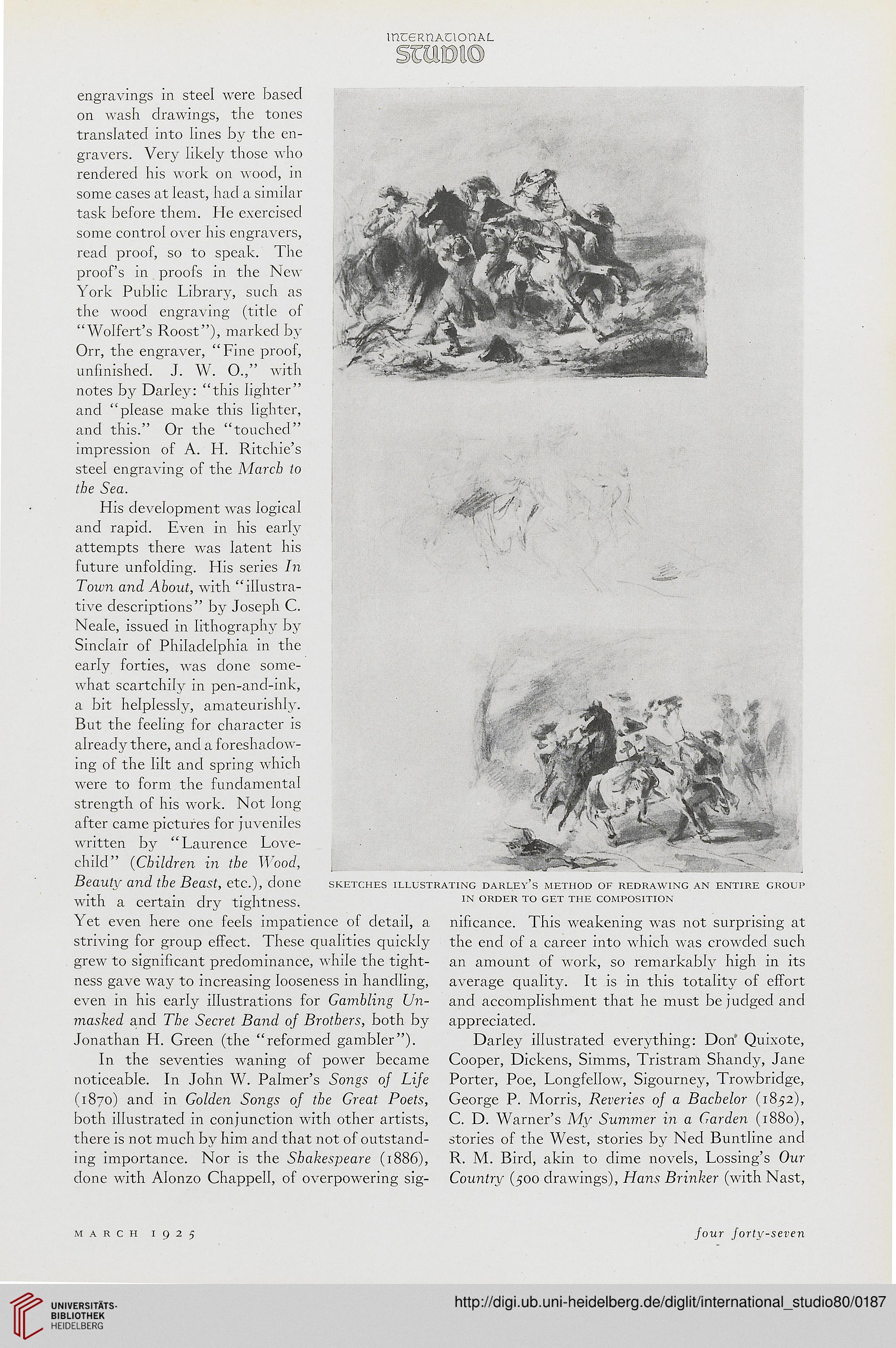mceRnACionAL
engravings in steel were based
on wash drawings, the tones
translated into lines by the en-
gravers. Very likely those who
rendered his work on wood, in
some cases at least, had a similar
task before them. He exercised
some control over his engravers,
read proof, so to speak. The
proof's in proofs in the New
York Public Library, such as
the wood engraving (title of
"Wolfert's Roost"), marked by
Orr, the engraver, "Fine proof,
unfinished. J. W. O.," with
notes by Darley: "this lighter"
and "please make this lighter,
and this." Or the "touched"
impression of A. H. Ritchie's
steel engraving of the March to
the Sea.
His development was logical
and rapid. Even in his early
attempts there was latent his
future unfolding. His series In
Town and About, with "illustra-
tive descriptions" by Joseph C.
Neale, issued in lithography by
Sinclair of Philadelphia in the
early forties, was done some-
what scartchily in pen-and-ink,
a bit helplessly, amateurishly.
But the feeling for character is
already there, and a foreshadow-
ing of the lilt and spring which
were to form the fundamental
strength of his work. Not long
after came pictures for juveniles
written by "Laurence Love-
child" (Children in the Wood,
Beauty and the Beast, etc.), done sketches illustrating darley's method of redrawing an entire group
with a certain dry tightness. in order to cet the composition
Yet even here one feels impatience of detail, a nificance. This weakening was not surprising at
striving for group effect. These qualities quickly the end of a career into which was crowded such
grew to significant predominance, while the tight- an amount of work, so remarkably high in its
ness gave way to increasing looseness in handling, average quality. It is in this totality of effort
even in his early illustrations for Gambling Un- and accomplishment that he must be judged and
masked and The Secret Band of Brothers, both by appreciated.
Jonathan H. Green (the "reformed gambler"). Darley illustrated everything: Don' Quixote,
In the seventies waning of power became Cooper, Dickens, Simms, Tristram Shandy, Jane
noticeable. In John W. Palmer's Songs oj Life Porter, Poe, Longfellow, Sigourney, Trowbridge,
(1870) and in Golden Songs of the Great Poets, George P. Morris, Reveries of a Bachelor (1852),
both illustrated in conjunction with other artists, C. D. Warner's My Summer in a Garden (ll
there is not much by him and that not of outstand- stories of the West, stories by Ned Buntline and
ing importance. Nor is the Shakespeare (1886), R. M. Bird, akin to dime novels, Lossing's Our
done with Alonzo Chappell, of overpowering sig- Country (500 drawings), Hans Brinker (with Nast,
march 1925
Jour forty-seven
engravings in steel were based
on wash drawings, the tones
translated into lines by the en-
gravers. Very likely those who
rendered his work on wood, in
some cases at least, had a similar
task before them. He exercised
some control over his engravers,
read proof, so to speak. The
proof's in proofs in the New
York Public Library, such as
the wood engraving (title of
"Wolfert's Roost"), marked by
Orr, the engraver, "Fine proof,
unfinished. J. W. O.," with
notes by Darley: "this lighter"
and "please make this lighter,
and this." Or the "touched"
impression of A. H. Ritchie's
steel engraving of the March to
the Sea.
His development was logical
and rapid. Even in his early
attempts there was latent his
future unfolding. His series In
Town and About, with "illustra-
tive descriptions" by Joseph C.
Neale, issued in lithography by
Sinclair of Philadelphia in the
early forties, was done some-
what scartchily in pen-and-ink,
a bit helplessly, amateurishly.
But the feeling for character is
already there, and a foreshadow-
ing of the lilt and spring which
were to form the fundamental
strength of his work. Not long
after came pictures for juveniles
written by "Laurence Love-
child" (Children in the Wood,
Beauty and the Beast, etc.), done sketches illustrating darley's method of redrawing an entire group
with a certain dry tightness. in order to cet the composition
Yet even here one feels impatience of detail, a nificance. This weakening was not surprising at
striving for group effect. These qualities quickly the end of a career into which was crowded such
grew to significant predominance, while the tight- an amount of work, so remarkably high in its
ness gave way to increasing looseness in handling, average quality. It is in this totality of effort
even in his early illustrations for Gambling Un- and accomplishment that he must be judged and
masked and The Secret Band of Brothers, both by appreciated.
Jonathan H. Green (the "reformed gambler"). Darley illustrated everything: Don' Quixote,
In the seventies waning of power became Cooper, Dickens, Simms, Tristram Shandy, Jane
noticeable. In John W. Palmer's Songs oj Life Porter, Poe, Longfellow, Sigourney, Trowbridge,
(1870) and in Golden Songs of the Great Poets, George P. Morris, Reveries of a Bachelor (1852),
both illustrated in conjunction with other artists, C. D. Warner's My Summer in a Garden (ll
there is not much by him and that not of outstand- stories of the West, stories by Ned Buntline and
ing importance. Nor is the Shakespeare (1886), R. M. Bird, akin to dime novels, Lossing's Our
done with Alonzo Chappell, of overpowering sig- Country (500 drawings), Hans Brinker (with Nast,
march 1925
Jour forty-seven




